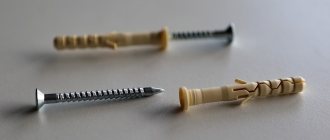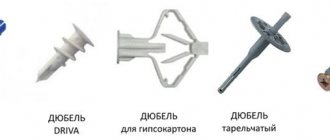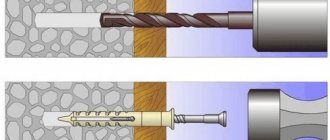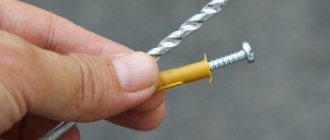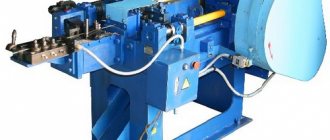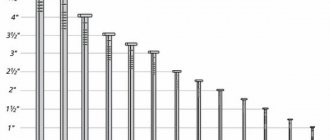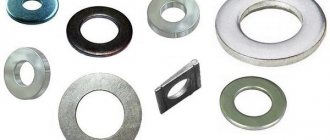All about dowel-nails: size table and fastener weight
Table of contents:
Let's imagine a typical task: you need to fix a heavy shelf for books on the concrete wall of a room. Self-tapping screws cannot be used. It will fall out. In Soviet times, a wooden dowel or, in other words, a chopik was inserted into a drilled hole for sealing. Nowadays a dowel-nail is used as a fastener: dimensions start from 5x30 mm. Here 5 is the diameter of the hole in the sleeve, and 30 is the length of the nail itself.
Typical sizes
Let us present the main characteristics of universal products in the form of a table:
| Type | Dimensions | Installation | Permissible load (brick, concrete) | ||||||
| d | L | t | d0 | h1 | Nbet. | Vbet. | Nbrick. | Vbrick. | |
| Expandet Nail Anchor | Ext. anchor diameter, mm | Anchor length, mm | Max. thickness of fixing item, mm | Diameter dia. holes, mm | Min. height depth holes, mm | Tensile load, kg | Cross-river load, kg | Tensile load, kg | Cross-river load, kg |
| 5×30 | 5 | 30 | 5 | 5 | 40 | 30,59 | 35,69 | 20,39 | 35,69 |
| 5×40 | 5 | 40 | 15 | 5 | 50 | 30,59 | 35,69 | 20,39 | 35,69 |
| 5×50 | 5 | 50 | 25 | 5 | 60 | 30,59 | 35,69 | 20,39 | 35,69 |
| 6×35 | 6 | 35 | 5 | 6 | 45 | 45,88 | 56,08 | 30,59 | 56,08 |
| 6×40 | 6 | 40 | 10 | 6 | 50 | 45,88 | 56,08 | 30,59 | 56,08 |
| 6×50 | 6 | 50 | 20 | 6 | 60 | 45,88 | 56,08 | 30,59 | 56,08 |
| 6×60 | 6 | 60 | 30 | 6 | 70 | 45,88 | 56,08 | 30,59 | 56,08 |
| 6×70 | 6 | 70 | 40 | 6 | 80 | 45,88 | 35,69 | 30,59 | 35,69 |
| 8×50 | 8 | 50 | 10 | 8 | 60 | 56,08 | 91,77 | 45,88 | 91,77 |
| 8×60 | 8 | 60 | 20 | 8 | 70 | 56,08 | 91,77 | 45,88 | 91,77 |
| 8×80 | 8 | 80 | 40 | 8 | 90 | 56,08 | 91,77 | 45,88 | 91,77 |
| 8×100 | 8 | 100 | 60 | 8 | 110 | 56,08 | 50,98 | 45,88 | 50,98 |
| 8×120 | 8 | 120 | 80 | 8 | 130 | 56,08 | 50,98 | 45,88 | 50,98 |
| 8×140 | 8 | 140 | 100 | 8 | 150 | 56,08 | 50,98 | 45,88 | 50,98 |
| 10×80 | 10 | 80 | 30 | 10 | 90 | 76,47 | 50,98 | 56,08 | 50,98 |
| 10×100 | 10 | 100 | 50 | 10 | 110 | 76,47 | 50,98 | 56,08 | 50,98 |
| 10×120 | 10 | 120 | 70 | 10 | 130 | 76,47 | 50,98 | 56,08 | 50,98 |
| 10×140 | 10 | 140 | 90 | 10 | 150 | 76,47 | 50,98 | 56,08 | 50,98 |
| 10×160 | 10 | 160 | 110 | 10 | 170 | 76,47 | 50,98 | 56,08 | 50,98 |
Table 1.
Here the lateral load is the weight that the dowel can support. This is a force directed vertically. That is, from the center of the edge of the fastener to the ground.
Sometimes it is useful to know how many kilograms there will be in 1000 pieces of fasteners. Especially if there is a lot of work to be done and the size of the warehouse is limited.
| Type | Weight 1000 pcs., kg |
| With polypropylene dowel | |
| 6×40 | 3,3 |
| 6×60 | 4,89 |
| 6×80 | 7,28 |
| 8×60 | 8,5 |
| 8×80 | 11,02 |
| 8×100 | 13,78 |
| 8×120 | 16,53 |
| 8×140 | 19,3 |
| 10×100 | 15,32 |
| Gun nails | |
| 4,5×30 | 5,1 |
| 4,5×40 | 6,45 |
| 4,5×60 | 7,7 |
| 4,5×60 | 8,84 |
table 2.
What is a dowel-nail
A dowel-nail is a metal fastener that is hammered or screwed into a plastic or metal body. The installation process looks like this:
A hole is drilled in the material.
Insert a bushing into the hole.
They hammer a nail inside.
The expansion mechanism expands and the fastener gets stuck in the concrete or brick. This results in a reliable connection. It does not lose its properties for several years.
The service life depends on the type of materials from which the elements are made and on external conditions. High humidity will cause even a galvanized rod to oxidize, and direct rays of the sun will destroy the plastic sleeve.
If the length of the nail does not exceed 50 mm, then its maximum curvature will be 0.1 mm.
We invite you to watch a video about the types and characteristics of dowels:
Mounting to various surfaces
Dowels are used to install cornices and ebbs. For work, take products with locking collars that prevent complete passage through the surface. Nail dowels are used when repairing baseboards and for fastening window frames before using polyurethane foam. When fixing the frame, it is necessary to take into account the ratio of the non-spacer and spacer parts. For drywall, it is better to use plastic or metal screws. In addition, such screws are excellent for quick installation. There is no need to pre-drill the wall. At the end of the products there is a drill and thread. To install the self-tapping screw, use a screwdriver that screws the dowel into the surface.
A “butterfly” or “molly” dowel is used for fastening into a plasterboard surface, since the self-tapping screw expands only in a complete void. Plastic and metal dowels are suitable for fastening into foam concrete. To fix large items with a large weight, dowels made of polyamide are chosen. They have a through hole and a top without spacers. Screwing in the screw is easy and quick. The thrust force increases. Due to this, the structure is able to withstand a lot of weight.
To install TVs and air conditioners, it is recommended to use standard dowels that come with the fasteners. The products are already designed for the weight of the device. The only nuance is the base of the material. If the equipment is mounted on a brick or concrete wall, then there will be no problems with fixation. To install chandeliers and sconces, it is better to use long screws with reinforced spacers. Corrugated dowels are able to withstand the weight of massive chandeliers when installed under suspended ceilings.
For heavier structures, dowel anchors are used. They are equipped with several parts - a threaded bushing and a spacer. The spacer is screwed into the bushing. The thrust force increases, resulting in a reliable and rigid fastening.
For repair and installation of pipes, it is better to use a dowel clamp, which has a special screw for fixation. It is also used for fastening wires.
During repair and installation work you cannot do without dowels. The choice of screws depends on the material of the product and the surface on which the structure will be attached. Each type of self-tapping screws has its own characteristics, weight and size. This article introduces the reader to the characteristics of screws and will help determine the choice of dowels for a particular material.
In the next video you will find types of dowels and their application.
Installation type
There are two ways to install the fastener:
Manual . You will need a hammer drill, screwdriver or hammer. You will have to drill a hole, insert a sleeve into it with your own hands, and then screw or drive in the rod.
Automatic . Installation is carried out using a gun. Use a special nail without a dowel with a strength of 53-56 HRC on the Rockwell scale.
The second option benefits from high installation speed. But the first is good because the standard rod can be pulled out without damaging the material or design.
Varieties
The house and dacha are full of things to do. Installation of cable ducts and thermal insulation, installation of drywall. Each case requires a separate type of fastener. There are no universal options. The following types of dowels can be distinguished:
Acoustic . Made from plastic and fiberglass. There are no metal parts, which means a high level of thermal insulation and moisture resistance.
Spacer S. There is no stop edge, so it can be installed at any depth in the plaster. The stopper protects against rotation.
Spacer MS . Made from durable nylon. With double-sided expansion. Compact. Fits well into drilled holes.
Umbrella . Long with a large hat. Designed specifically for installation of thermal and hydraulic insulation.
For aerated concrete GB . Features spiral ribs. This design ensures reliable fixation in soft material.
For steps TB and TBB . Designed specifically for attaching steps to metal profiles or solid materials. Prevents squeaking.
Metal . Withstands heavy loads. Does not rust due to galvanization. Easy to install. Does not lose its holding properties for a long time.
Chemical . Consists of a polymer that hardens after insertion into the mounting hole. Suitable for hollow materials.
Butterfly . Equipped with a special clamping mechanism designed for fixing thin sheets of drywall inside.
Facade . Features increased length. Due to this feature, it can withstand heavy loads.
Peculiarities
A dowel screw is a fastening for structures that has special antennae for fixing it to the surface. When spaced with a screw or screw, a frictional force arises, which holds the dowel in the structure and prevents it from turning. Dowels are made from various materials and can have different weights and sizes. Depending on the material used, self-tapping screws have their own characteristics. For example, products made of polypropylene cannot withstand low temperatures. They are not recommended for outdoor use. Nylon elements are universal. They can be used both when working outdoors and indoors.
The dowel may have a locking collar. The screw is made from nylon and is used for installation work outside. Its peculiarity lies in special stoppers. They prevent the screw from falling into the hole.
Self-tapping screws without a shoulder also have their own distinctive feature. The product is made from polyamide and has a through hole with longitudinal ribs and a non-expandable upper part. The structure of the product makes screwing in a screw much easier and increases the thrust force. The non-expandable top protects the surface from cracks due to its immobility.
It is also worth noting that such dowels are resistant to weather conditions. They can be used for street facade work. There are types of dowels for a construction gun. The products are practical, effective and reliably fix parts to the surface.
All fastening elements are produced in accordance with GOST. Some specifications are subject to change. These include weight, diameter, length, structure. But the basic norms must be strictly observed. Manufacturers strictly adhere to the following standards according to GOST:
- material of manufacture;
- min and max indicator of rod curvature;
- protection from a galvanized layer - galvanization is applied in compliance with the rules of galvanization and passivated technology (coating thickness - 6 microns);
- diameter of the washer and metal rod.
It is worth familiarizing yourself with the numerous types of products and their properties in more detail.
Dowel-nail 6x40, technical characteristics
Every set of tools should have dowel-nails; this is an indispensable component in many repair and construction works.
Thanks to the type of nail in question, the installation process becomes efficient, which means that both effort and time are saved during fastening. It should also be noted that dismantling, as well as installation of the dowel-nail, is quite simple, and fastening with such an element is very strong and durable. In order to quickly dismantle this element, you must first carefully unscrew the nail inserted into it from the dowel itself, and only after this procedure can you remove the “cut” of the nail with a regular screwdriver (preferably a Phillips screwdriver).
Among consumers during fastening work, it is common to use a 6x40 mm dowel-nail. The design of the fastening element in question is quite simple, which makes it convenient to use. The price category of this fastener is quite low, so purchasing such a product will not be difficult for anyone. At any point of sale of hardware and fasteners you can find an unlimited number of such nails.
Where is the 6x40 dowel nail used?
The fastening parts in question are used everywhere and are considered universal nails. Their range of applications is quite wide; they can be used to attach various types of structural elements to materials such as stone, various types of brick, reinforced concrete, etc.
Experts do not recommend using dowel-nails for hollow-type materials and porous surfaces. A 6x40 dowel-nail, the technical characteristics of which will be discussed below, is driven in with a hammer, but before that, do not forget about the preliminary preparation of a special hole where the fastener in question will be inserted.
The high demand for the element in question is due to three criteria and, at the same time, the advantages of such a nail, namely: extremely simple design, low cost and practicality. Dowel-nails 6x40 are popular during the installation of support-type structures, because in this process you simply cannot do without them.
Some points worth knowing
This type of special fastener has long been used in a wide variety of works, where fastening becomes a necessary process, according to technology. Below are a few important points to consider:
The two main parts that make up the element are the nail and the dowel itself. Such a connection allows you to attach objects to materials such as concrete, brick, stone without destruction.
Other materials that are classified as solid and high-density can also be fastened. It is possible, among other things, to cite the types of appropriate fasteners suitable for installation processes, where fiberboard, chipboard, and plasterboard serve as the main materials for connecting to the bases.
As for the length, it varies, starting from 30 millimeters. The longest specimens reach 160 millimeters in length. This type of dowel-nail is used for thermal insulation. The wide pressing cap gave rise to the fact that sometimes such a dowel is called a disc dowel.
Technical characteristics of the fastener
Most construction and finishing works cannot be done without the use of this part. It should also be noted that the dowel-nail is always supplied exclusively as a set, so you don’t have to look for and purchase a separate “frame” for the nail.
We would like to inform you that under no circumstances should screws replace nails; this replacement will be inappropriate, incorrect and impractical. A 6x40 mm dowel-nail, the characteristics of which are its advantages in comparison with similar types of fasteners, can be made of different materials (nylon, polypropylene, polyethylene).
The fastener in question consists of several parts, directly from a dowel (hence the name of this type of nail), double-spacer, on the surface of which there are no tangential fixing elements in the form of ailerons, or, for example, mustaches. The top of the part (later the head) can be of several shapes - cylinder, mushroom-shaped and secretive.
The second element of the 6x40 mm dowel-nail is, directly, a nail in the form of a screw. It is usually made of carbon steel, but this is not the only layer that is used to cover the screw. Among other things, a zinc layer is applied to the surface of the fastening element in question, which serves both for protection and performs a decorative function.
On the rod of the fastening element there is a smooth part, as well as a tip. It is immediately worth noting that the shape of the head of the element in question will ultimately depend on the shape of the inlet hole.
On the cut of this part there is a so-called slot, which serves as a necessary element for the possibility of replacing the nail itself if necessary.
Do not forget about the calculated maximum load that can be applied to a 6x40 mm dowel-nail (for different materials, this indicator will be different):
The mass of the fastening element in question depends directly on the type of this product. So, if this is a mounting type dowel, then its weight will be within 7 grams.
A 6x40 dowel-nail, the main technical characteristics of which were discussed in detail earlier, is made of polypropylene and weighs 3.4 grams. If the side is cylindrical, its mass will not exceed 3.3 grams. The mushroom-shaped dowel weighs 3.3 grams, the same as the cylindrical one. The Polish-made dowel-nail weighs almost 4 grams.
In principle, the mass of the fastening element in question depends on several factors, namely the country of manufacture, the purpose and method of manufacture, and the material from which it will be made.
What weight can a chandelier be hung on drywall?
Particular attention should be paid to attaching chandeliers and lamps to the ceiling made of fire-resistant plasterboard Knauf. The weight of an object fixed to the ceiling without an additional fastening device should not exceed 3 kg.
Interesting materials:
Who is the author of the story two comrades? Who is the author of the story boys? Who is the author of the story Quiet Morning? Who is the author of the quote “He who walks can master the road?” Who is bigger: Golden Eagle or Bald Eagle? Who will be on the jury 60+ votes? Who was the author of The Tale of Bygone Years? Who was the grandfather of Vladimir Monomakh? Who was in space before Gagarin? Who was the main character of detective novels about Sherlock Holmes?
Material and coating
Most often, the part is made of various types of plastic (polyamide, polypropylene, etc. In practice, there are also dowels made of metal (rare cases, but they do occur). The nail in the element in question is an alloy of metals, but besides everything else , coated with zinc.
It is worth noting that there is a 6x40 dowel-nail with a thread, and there is one without it, so when choosing the fasteners you need, you should pay attention to this nuance.
Source
How to choose a dowel?
Content
What makes a good master? Nothing is too small for him! He also pays great attention to the choice of dowels. And this is no coincidence: an incorrectly selected or low-quality dowel can completely ruin the result of long-term work. Which dowel should I buy? How to choose a drill for a dowel? Let's find out!
Advice from professionals
It is better to select a drill for a dowel in accordance with the recommendations described above. If you have to punch a hole through a hard surface, a good option would be to take a nozzle 2-4 mm smaller, turning on the impact mode on the drill. This will avoid chipping and deviating direction to the side.
- Remember - perforation always expands the area of impact of the drill.
Afterwards, a cutting mechanism is installed according to the size of the insert tenon. The equipment is switched to standard mode. The hole widens, maintaining smooth edges. Experts recommend blowing out the resulting hole, removing dust and residues that have accumulated after drilling. This will ensure reliable adhesion of the element to the base.
An important detail - even if a hole is made in soft surfaces, you need to use 2 drills - first 1 mm smaller, then according to the diameter of the dowel. This will allow you to get a perfectly sized hole.
Source: www.moy-house.ru
Let's see what the wall is made of
Concrete, brick
Spacer dowels will do . There are several varieties of them. The expansion dowel with spikes (often called “Chapai”) has teeth and two spikes. When installed, it expands and fits tightly into the wall. The spikes rest against the wall and prevent the dowel from turning. They are especially important in vertical installations where the load acts downward.
The reinforced expansion dowel (hedgehog dowel) for the concrete screw does not have spikes. But during installation, it expands along its entire length, and the teeth with which its body is covered prevent it from turning. Suitable for heavy loads.
The three-expansion dowel (T-dowel) is also designed for high loads. Often used to secure furniture, shelves and other heavy objects. It has a spacer part - walls with ribs that are securely fixed in the wall, and a non-spacer part - a side that protects against falling into the hole.
From left to right: expansion dowel with spikes, expansion dowel reinforced, three-expansion dowel
Aerated concrete, foam concrete and other porous materials
There are two types of fasteners most commonly used. Due to the large number of these same cutters, the dowel with cutters is firmly fixed in the foam blocks. A dowel with screw ribs is also able to hold securely in such materials: its ribs provide excellent grip.
From left to right: dowel for aerated concrete with cutters, screw dowel for aerated concrete
Drywall and gypsum board
Driva screw dowels are used . With their help, you can secure cable ducts, mount baseboards, light sources, etc.
Another option is butterfly dowels . They are ideal for securing heavier structures - typically up to 16 kg. When installed in a hole, they spread their “wings”, creating the strongest possible connection.
From left to right: Driva dowel, butterfly dowel
Size range of types
According to standards, dowels are made with a diameter of 5, 6, 8, 10 mm. There are also not so common ones, for example 4 mm. The length varies from 20 to 150 mm. The size of the dowel-nail is selected according to the design parameters. For the symbol, two values are indicated in the marking, the first is the diameter, the second is the length. The most popular size range of fasteners is 4x20, 4x40 mm, 5x30, 5x40 mm, 6x30, 6x35, 6x40, 6x50, 6x52, 6x60 mm, 6x70 mm, 6x80 mm, 6x100 mm, 8x40, 8x50, 8x60, 8x80 mm, 8x1 00 mm, 10x50, 10x60, 10x80, 10x100 mm, 10x120 mm, 10x160 mm, 12x60, 12x70, 12x80 mm.
Dowel fasteners are divided into types.
- Umbrella (or facade). It features a large cap and length. Designed for fixing large layers of insulation. The nail can be made of steel or impact-resistant plastic.
- Chemical. Fastening occurs due to the adhesive capsule. There are chemical dowels of ampoule and injection types.
- KVT (or fasteners for aerated concrete). During installation, threads are cut, but the base material itself is not destroyed. Can withstand loads from 400 to 600 kilograms.
- Universal. Designed for both surfaces with voids and solid ones. When installing a nail, the sleeve “twists” and forms a kind of knot that provides reliable adhesion and fixation.
- Molly (or collapsible spring) dowel. It is made of steel and during installation “folds”, mounted in thin and hollow walls. People may also call it a butterfly dowel.
- Spacer. It has additional mounting lugs; it can be three-spacer, four-spacer or six-spacer. A threaded nail is driven in with a hammer.
- Frame. Its distinctive feature is the shape of the non-expanding part, it is elongated.
- Metal for concrete. For fastening it is best to use a special gun, but installation can be done manually. The holes must be prepared in advance.
It is worth noting that some models come complete with a washer for sealing.
We take into account what we will attach
Some building materials and structures cannot be fastened with conventional dowels. They require special, highly specialized fasteners, otherwise all the work may go down the drain. Let's look at such examples.
Thermal insulation and waterproofing
The most common option is a mushroom dowel (plate-shaped). Its large head allows you to attach polystyrene, polystyrene and other similar materials as firmly as possible and at the same time accurately.
Plastic or metal nails can be supplied with these dowels. Fasteners with plastic nails are suitable for lightweight structures and do not place unnecessary load on the wall. Its main advantage is that it is not subject to corrosion, so it can serve for a very long time. In addition, it has low thermal conductivity, so heat loss will be minimal.
Dowel dowels with metal nails can support more weight. Unlike plastic ones, they do not break or bend during installation. However, they are susceptible to corrosion and can freeze. dowels with a thermal cover were developed . They are distinguished from standard ones by the presence of a plastic plug that protects the nail from cold and moisture.
Facade profiles, brackets, battens, etc.
Typically , anchor or façade dowels . They can be installed in concrete, hollow and solid bricks, foam concrete, etc. Due to their design, they provide reliable fastening even for heavy materials.
Cables and wires
Dowel clamps are suitable - plastic staples with teeth at the ends. These teeth securely hold the dowel in the wall, and the clamp securely fixes the wire. Working with such dowels is very simple: no need to use nails.
Painting, photo frame, decor
Selection rules
Before purchasing dowel fasteners, you need to find out what surface it will be mounted on.
An important parameter when choosing is the diameter and length of the fastener. The larger they are, the greater the load it can withstand. It also takes into account the thickness, surface density and the presence of voids. For example, for a plinth, the most popular universal dowels with a diameter of 0.6 centimeters and a length of up to 8 centimeters are suitable. This is one of the reliable mounts, but if the structure needs to be dismantled, problems may arise. It must be remembered that before installation, all the necessary markings are applied for mounting on the wall and under the holes on the baseboard, which will later be drilled in advance. The diameter of the holes must be equal to the diameter of the dowel.
For a toilet with small dimensions, installation using dowels will be the most practical option. Rubber washers or gaskets should be included with the hardware. Here you also need to measure the surface and mark where the fasteners will be inserted. Next, a hole is drilled in the tile with a drill, and then in the concrete with a construction hammer. Façade specimens are suitable for insulation and polystyrene foam; at their base there is a special serrated groove, thanks to which the dowel-nail is securely attached to the base.
As a fastener for a TV, for a wall-mounted hallway, for hanging a kitchen, shelves and other furniture that will be installed in a vertical plane, it is better to use metal nails for aerated concrete or frame ones.
In the next video you will learn about the types, characteristics and features of installing dowel-nails.
Selecting a dowel based on material of manufacture
Metal dowels
+ High strength and rigidity
+ High load-bearing capacity
– Loss of properties during deformation
Usually made of galvanized stainless steel. More reliable and durable - made from special alloys with chromium, titanium, etc. They resist corrosion better. However, their cost is quite high, so they are used most often for critical work.
Plastic dowels
+ Not subject to corrosion
+ Do not lose their properties when deformed due to high elasticity
– Cannot be used in fire hazardous areas
– Have less rigidity and load-bearing capacity than metal ones
| Plastic dowel material | Advantages | Flaws |
| Polyethylene | Resistance to acids, deformation and low temperatures | Over time it begins to crack |
| Polypropylene | Heat resistance up to 140 °C, high hardness | Over time it begins to crack. Low resistance to frost |
| Polyamide (nylon) | High strength, rigidity, resistance to vibration and mechanical damage. Considered the most reliable of all materials for plastic dowels | Hygroscopicity, which makes it impossible to work in frost or high humidity |
Peculiarities
A dowel is a sleeve made of any material with ribs located on the outside of the product to securely fix and prevent rotation during operation.
The main distinguishing feature of a nylon dowel is its longer service life. It can last more than 10 times longer than polyethylene. They have been in use in European countries for more than half a century. They are made from a special material - polyamide, which does not age over time and does not shrink. These properties of this type of plastic allow you to use nylon dowels for many years without fear for their reliability.
Another feature is the fairly wide temperature range at which such fasteners can be used - it ranges from -40 to +80 degrees Celsius. It should be noted that it can be used at lower temperatures at your own peril and risk: deformation and rupture may occur, or the dowel will not completely fit into place. But, as practice has shown, it will still hold better than regular polyethylene.
Due to the high degree of strength and reliability, this type of fastener can withstand loads approximately 3 times higher than fastening rods made of simple plastic. The only negative compared to the others is the higher cost due to the fact that a higher quality type of plastic is used.
Nylon fasteners have another interesting feature: if you put them in water, they will sink, unlike their other plastic counterparts.
